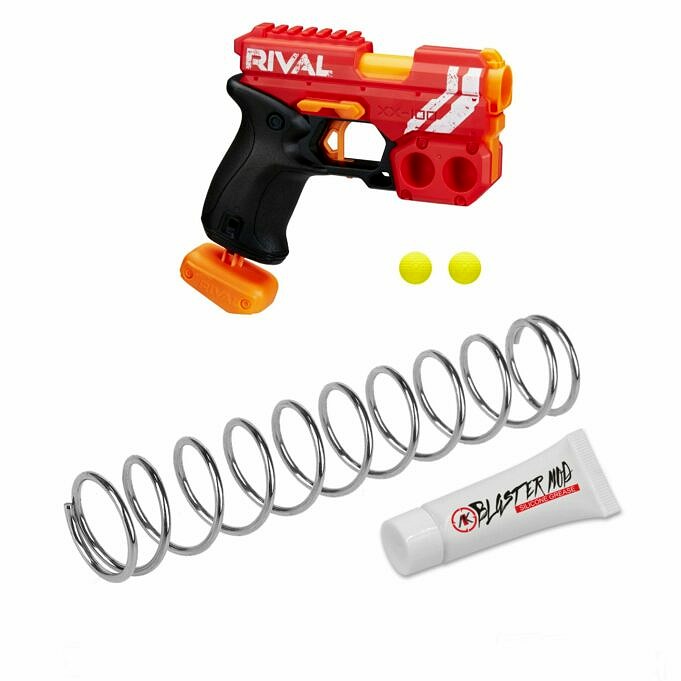The Nerf Rival Knockout can be a blaster. 90+ fps, single shot, breech-loading. People will eventually decide that it should fire faster or use Rival balls. Here’s some information that isn’t covered in the review.
Packed In Tight
The entire internals. The breech mechanism sits above the trigger, and the safety directly beneath it.
Looking at the AR that isn’t an AR. The white background behind the plunger can be seen.
The plunger tube’s base, which was solvent welded in. The long orange rod blocks the trigger until the plunger rod is pushed back up.
The plunger rod moves the small orange plate. The tension is provided by the spring-loaded white rod. The remaining large orange piece is the catch.
The Knockout, of course, draws comparisons to the Jolt (and the Bigshock). To be a Rival blaster, however, it must pack many features into a small space.
Apart from the arrangement of the pieces, it is important to note that there is no AR or safety valve. These are usually pushed open when there is a round, and then closed as the round fires. This both keeps the round at acceptable velocities for a store-bought blaster and cushions the impact of the plunger with whatever air remains.
The Knockout however allows air to flow freely as there is no restriction on how much. Instead, we have a spring-loaded tab which pushes the ball into the barrel’s tighter section. You can do this by hand, of course, but the tab makes for consistent placement.
The breech itself is also worth noting.
The shell has around 4 cm of space, but only opens up halfway for loading Rival rounds. If you need more space, there are stops on the channel where the breech rides. These can be removed or reworked. If you choose to use darts, this can be ignored and you can just use a brass breech.
For my experimentation, I used needle nose pliers to pull out the loading tab, then a thin screwdriver to peel up the lightly bonded support structures. This left me with a hole measuring approximately 3/10 cm in diameter.
The Plunger
Take it out of the container. The oval-shaped top of this plunger is worth noticing.
The stack’s weight.
The handle is a heavy weight. This, plus the plunger rod, is quite a bit of extra weight compared to the whole system. This is why it’s important to push the plunger rod back up before firing.
The plunger is quite large (and hollow). As noted, the plunger rod has to be pushed up prior to firing. The reason? It ends up being a significant chunk of the entire systems mass, and we need the accelerated mass to be as light as possible. To that end, the plunger itself is light and hollow, which allows plunger rod retraction while primed.
The top of the plunger is ovoid, rather than simply round, and has padding at the end. This fills in the narrow space between the main body of the plunger tube and the barrel.
The o-ring on the plunger measures roughly 33.2mm in diameter. The spring has a diameter of approximately 24mm.
The snap-on tabs at the end of the plunger have lots of solvent welding. You can remove the tabs by removing the end cap.It will be difficult to reassemble the vehicle. The system is under some pre-compression, and parts will want to move apart before you get the shell halves together.
Here’s A Highly Unscientific Demonstration!
I wrapped a length of PETG barrel tubing 19 cm in electrical tape and stuffed it into the barrel. After removing the loading tab, I know, highly professional work.
It worked well for demonstration purposes. With the initial pull of the plunger rod, I was able to vacuum-load darts from my front. Importantly, darts hit in the 140s after being properly seated at the barrel’s beginning. Half of the darts are at the lower end of this range. A good dart/barrel match can make a superstock single-shot pistol that is fun and you can swap the barrel for Rival functionality.

